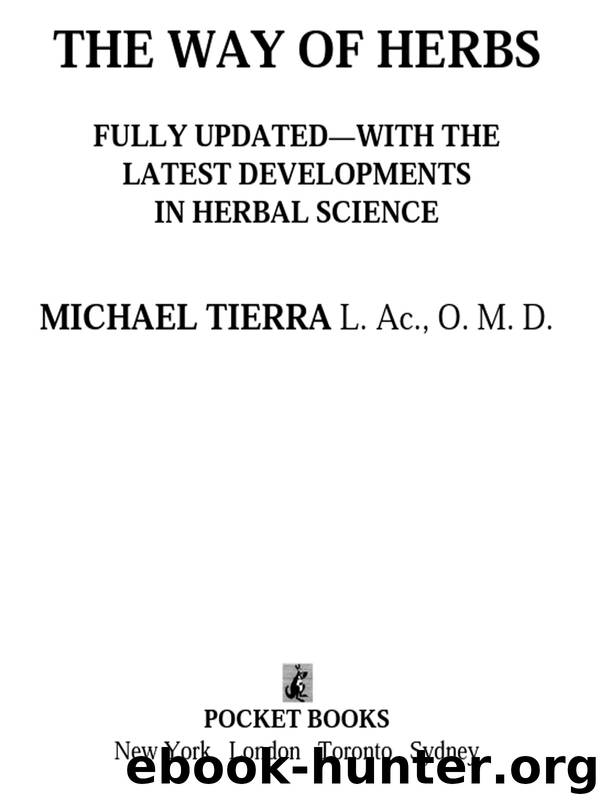The Way of Herbs by Michael Tierra

Author:Michael Tierra
Language: eng
Format: epub
Publisher: Pocket Books
Published: 1998-07-24T16:00:00+00:00
10
CHINESE HERBS
China is perhaps unique in the world in its long commitment to preventative medicine through the use of herbal tonics. The tonic herbs have several uses, including direct treatment of acute ailments, building strength in the recovery process, balancing the body’s energy and preventing disease from occurring. These herbs are combined to make tonic soups providing nourishment and gentle stimulation to the organs. The Chinese herbs are becoming more readily available in the West, and many of the ones described here can be purchased in herb stores around the United States.
To make the herbal soup, combine six to seven grams (about one-quarter ounce) of each of the desired herbs in a large nonmetallic pot. Use a quart of water per ounce of herbs and simmer for an hour. Drink one cup of tea, once per day, reheating the soup each day until it is all used. Always include some licorice in the formula.
Most of the Chinese herbs mentioned in this book are considered to be tonics of either the Yin-body, Yang-energy, Yin-blood or tonics for specific organs. Usually these herbs are used in a powerful Chinese herb soup, They are never cooked in a water soluble metal container as this will dilute their properties. For the more difficult diseases involving deficiency, they should be regularly used over a long period of time to help “build up the deficiency,” the primary therapeutic principle of Chinese medicine. This is in contrast to Western herbalists who, coming from a tradition of excess meat eating and the use of rich foods, advocate a more eliminative approach to health.
Since the herbs discussed here are among the most frequently used in Chinese medicine, I would like to suggest some approaches for the novice in beginning to integrate them into his health regime.
First we should classify the herbs according to their tonic capacities. Yang or energy tonics include the following: aconite, astragalus, don sen, ginseng, eleuthero, ephedra, fu ling, licorice, ho shou wu, pai shu, and salvia (dang shen). Yin or blood tonics include: dong quai, ho shou wu, lycii, rehmannia, peony, and tienchi.
There are also some herbs that are Yin-cooling, thus helping to detoxify the blood and remove inflammation and heat from the internal organs and body in general. These include: bupleurum, honeysuckle, chrysanthemum, and rehmannia (raw).
Herbs that are stimulating and warming to metabolic functions include: cinnamon, ginger, aconite, and citrus peel (especially tangerine). These have more extreme warming or stimulating action and also help digestion. Other herbs that help to build warmth include pai shu, dong quai, Korean ginseng, prepared rehmannia, don sen, eleuthero, astragalus and tienchi.
Following the principles of Yin and Yang, one might determine what energy is most deficient in and use a combination of those herbs that tend to augment the areas of Yin or Yang deficiency. However, it is important to remember that Yin and Yang are interconnected, and while one who is deficient in “chi” or energy might want to take a combination of ginseng, don sen, and astragalus,
Download
This site does not store any files on its server. We only index and link to content provided by other sites. Please contact the content providers to delete copyright contents if any and email us, we'll remove relevant links or contents immediately.
| Acupuncture & Acupressure | Aromatherapy |
| Ayurveda | Chelation |
| Chinese Medicine | Energy Healing |
| Healing | Herbal Remedies |
| Holistic | Homeopathy |
| Hypnotherapy | Massage |
| Meditation | Naturopathy |
| Reference |
Inner Engineering: A Yogi's Guide to Joy by Sadhguru(6455)
The Power of Now: A Guide to Spiritual Enlightenment by Eckhart Tolle(5356)
Fear by Osho(4502)
Ikigai by Héctor García & Francesc Miralles(3909)
The Art of Happiness by The Dalai Lama(3855)
The Ultimate Bodybuilding Cookbook by Kendall Lou Schmidt(3716)
Yoga Therapy by Mark Stephens(3577)
The Little Book of Hygge by Meik Wiking(3453)
Why Buddhism is True by Robert Wright(3294)
The Healing Self by Deepak Chopra(3273)
Being Aware of Being Aware by Rupert Spira(3096)
The Hatha Yoga Pradipika (Translated) by Svatmarama(3087)
Shift into Freedom by Loch Kelly(3035)
Wild Words from Wild Women by Stephens Autumn(2944)
Work Clean by Dan Charnas(2904)
Happiness by Matthieu Ricard(2892)
More Language of Letting Go: 366 New Daily Meditations by Melody Beattie(2862)
Yoga Body & Mind Handbook by Jasmine Tarkeshi(2754)
Why I Am Not a Feminist by Jessa Crispin(2591)
